|

by Steven J. Smith
from
Electrogravities Website
|
Disclaimer:
ALL information contained herein is derived from
public sources, widely accepted scientific principles,
and/or authors first hand experience. The author has NO
written or verbal agreement with ANY governmental agency
forbidding disclosure of the information contained
herein. In disclosing this information, the author is
exercising his right to free speech as a private citizen
of the United States of America. While the author
advocates the discovery and disclosure of the American
covert weapons infrastructure, NO ATTEMPT should be made
to interfere in any way whatsoever with the personnel
and/or operations of said infrastructure. The proper
method for achieving discontinuance of these activities
is through court ordered injunctive relief. |
Introduction:
What does the Brookhaven national laboratory, Montauk Point state
park, the decommissioned Shoreham nuclear power plant, and the
mid-air explosion of TWA flight 800 have in common?
The primary
purpose of this paper is to delineate the connection between these
seemingly unrelated locations and events. The paper also serves as a
practical example of the American covert underground infrastructure,
the methods employed by it's architects, and the goals of it's
workforce.
Overview:
While the Montauk site is at this point, well documented by many
different authors, most fail to fully appreciate it's
interrelationship to the other locations covered in this paper. The
central player is the Brookhaven national laboratory. As we shall
see, the other locations and events exist in relationship to the
capabilities and geographic location of this laboratory.
I have included an aerial photo of
eastern Long Island to show the geographic relationships.
Contents
-
Brookhaven-Montauk-Shoreham Photo
-
Brookhaven Analysis
-
Particle Beam Energy Calculations
-
Shoreham Analysis
-
Montauk Analysis
-
TWA Flight 800 Analysis
Brookhaven-Montauk-Shoreham Aerial Photo
Aerial Photo Analysis:
The photo below is a composite image, created from USGS (united
states geological survey) aerial maps, showing the eastern end of
Long Island, New York. This photo illustrates the geographic
relationships between the various facility locations and events.
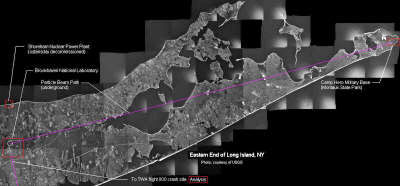
Back to Contents
Brookhaven
Analysis
Aerial Photo Analysis:
The photo on the right is an aerial view of the Brookhaven National
Laboratory (BNL). One of ten national laboratories overseen and
primarily funded by the Office of Science of the U.S. Department of
Energy (DOE). The large circular area in the upper middle of the
photo is the 2.4 mile radius RHIC (relativistic heavy ion collider).
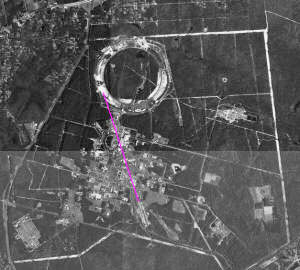
Photo Courtesy of
USGS
At the time of this photo (august 1994),
the RHIC was still under construction. Below and slightly to the
left, a second smaller ring called the AGS (alternating gradient
synchrotron) is also visible. These devices are collectively known
as particle accelerators. The RHIC uses super conducting magnets
cooled by liquid helium, and requires 5 million watts of electrical
energy just for refrigeration.
While no figures are available for total
RHIC power requirements, a value in the range of 20 to 40 times the
refrigeration load is a safe assumption. This would equal 100
million to 200 million watts of electrical power. Now we see the
true purpose of the Shoreham nuclear power facility.
Although the actual particle accelerators are buried in underground
tunnels, many of the support structures are above ground. Notice
that most administrative, and research facilities are laid out in a
grid pattern, but some structures are oriented odd angles. In
particular, the purple line (image above) connecting the left hand edge of the RHIC ring and the right hand edge of the AGS ring, terminates at a
group of structures in the lower middle of the photo.
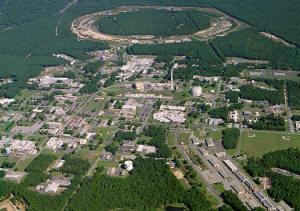
Photo Courtesy of BNL
In the upper color photo, these structures are located in the lower
right hand corner, and appear to be a row of metal sheds, with the
first one set at a slightly different angle, as if they just happen
to follow the road. In reality, their location and orientation is no
mere accident of convenience.
These building house the support
equipment for a first generation particle beam weapon system. It is
also no accident that a line drawn from bottom end of this row of
structures intersects the crash site of TWA flight 800.
The RHIC and AGS rings are used to accelerate packets of subatomic
particles to velocities near the speed of light. These packets are
then shaped, focused, and launched at the target by equipment
located under the row of metal sheds.
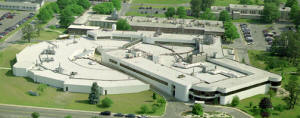
Photo Courtesy of BNL
The color image above shows a
close-up view of another installation located along this same
particle beam alignment, known as the NSLS (national synchrotron
light source) also visible in the previous photo. This facility uses
an electron (ring) accelerator to produce high power ultraviolet
laser light. The laser beam serves two purposes.
At low power, it's used for target
acquisition and tracking. However it's primary (high power) function
is to create a partial vacuum "tunnel" through the atmosphere to the
target. This allows the particle beam to travel without attenuation
or scattering by air molecules.
The facilities listed in this analysis are examples of the "dual
use" doctrine. In other words, these facilities comprise an advanced
particle beam weapon system, disguised as legitimate scientific
research laboratories. The majority of scientists and technicians
working at this site have no idea their efforts are being used to
conceal such a sinister purpose.
To hide this monstrous device behind a
facade of innocent scientific pursuit, is typical of the people and
organizations that have created the covert underground
infrastructure in America.
Back to Contents
Particle Beam
Energy Calculations
Particle beam overview:
The following are direct quotes from a public relations document
called "RHIC by the Numbers", published by the Brookhaven National
Laboratory (BNL).
Quote 1:
RHIC's beam travels at 99.995 percent the speed of light
(186,000 miles per second, or more than 300,000,000 meters per
second).
Quote 2:
RHIC's beam is not continuous - it's made up of 57 separate
"bunches," each containing billions of ions.
Quote 3:
RHIC ions are so small that, even at nearly the speed of
light, the force of their impact is about the same as the impact
of two mosquitos colliding.
From
the BNL website, we discover that
gold (Au) atoms are used for the particle beam.
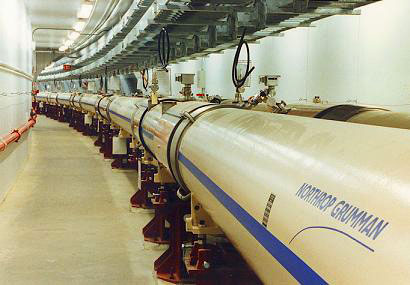
RHIC Tunnel.
Photo Courtesy of BNL
Particle beam energy calculations:
The energy contained in any
moving object, be it a car, snow ball, or particle beam composed of
gold atoms is calculated as follows:

[Eq. 1]
Where:
E = Energy in Joules.
M = Mass in kilograms.
V = Velocity in meters per second.
The mass of a gold atom is 3.2697-21
grams, and the mass of 2 billion gold atoms is 6.5394-12
grams or 6.5394-15 kilograms. Thanks to Einstein's
relativity, the effective mass of any object traveling near the
speed of light increases by:

[Eq. 2]
At 99.995% of light speed, the effective
mass is slightly more than 100 times the rest mass, therefore our 2
billion gold atoms have an effective mass of 6.5394-13
kilograms. Next, the speed of light is 299,792,458 meters per second
in a vacuum, and 99.995% of light speed is 299,777,468 meters per
second.
Therefore:
E = 6.5394-13 *
299,777,4862 * 0.5 = 29383.7 Joules
And since the RHIC stores 57 "bunches"
or packets of particles, the total energy is: 57 * 29383.7 =
1,674,871 Joules. This is nearly 3 times the energy of a 3500 pound
automobile crashing into a wall at 60 miles per hour! And all of
this energy concentrated into 57 packages, each smaller than the
period at the end of this sentence, AND traveling at nearly the
speed of light.
It seems quote number 3 (above) tells the truth, but NOT the whole
truth...
It should be mentioned that according to BNL, the RHIC did not
produce a particle beam until July, 1999. However, given the covert
nature of DOE, this date is suspect. Furthermore, as the line drawn
on the aerial photo of BNL clearly shows, the AGS ring is also
capable of supplying particle beams to the weapons system buildings.
Back to Contents
Shoreham
Nuclear Facility Analysis
Aerial Photo Analysis:
The photo on the right is an aerial view of the Shoreham nuclear
power generation facility, owned by Long Island Power Authority (LIPA).
According to LIPA, this facility was decommissioned in June,1987 and
the nuclear fuel removed. This photo was taken in August 1994. Note
the parking lot full of cars, in the upper right hand corner of
photo. Also note the cars parked along left hand edges of buildings
in lower left corner of photo.
Another unusual feature is the secluded complex of buildings in the
upper middle of the photo. Notice how a strip of forest was left
between the complex and the beach for concealment. Also, notice the
concealed low traffic road connecting this complex to the road in
center of the photo.
One other interesting feature is the
trail leading from the beach, to the right hand edge of the complex.
When taken all together, this complex has the classic signature of a
rural underground access point.
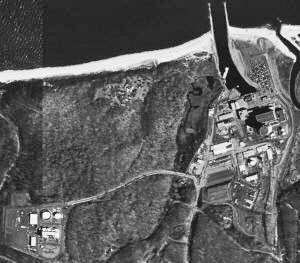
Photo Courtesy of
USGS
This facility is fully operational, and
being used to supply electrical power to the covert particle beam
weapon system at Brookhaven national laboratory.
Note: at the time of it's decommissioning Gov. Mario Cuomo,
coerced New York's public-utilities commission into the following
agreement with LIPA: The power authority could pass the cost of
Shoreham along to its customers only if it agreed not to operate the
plant. Another example of how the cost of American underground
infrastructure is covertly shifted to an unsuspecting citizenry.
Back to Contents
Montauk Point
Analysis
Aerial Photo Analysis:
The photo on the right is an aerial view of Montauk Point state
park, and Camp Hero military reservation, both located at the
eastern tip of Long Island. The loop highway and large parking lot
in the upper right hand corner are adjacent to the Montauk light
house (a national monument).
The complex of roads and structures
stretching from the left hand edge of the photo, and continuing to
the right hand edge comprise the Camp Hero military reservation. For
many years there has been a continuing controversy surrounding the
Camp Hero military reservation (CHMR).
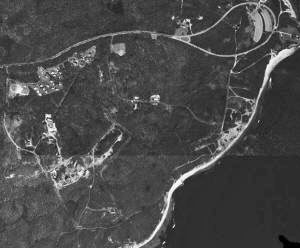
Photo Courtesy of
USGS
According to many accounts, this site
has been secretly used for experiments in mind control, advanced
weapons research/testing, and as a time machine portal. These
clandestine endeavors are commonly and collectively known by the
term "Montauk Project".
At first glance,
mind control, particle beam weapons, and
time
travel may seem to have very little in common. However, all three
tasks make use of high power electro-magnetic energy. The particle
beam accelerators at Brookhaven are used to supply the needed energy
(directly in the case of particle beam weapons, and indirectly in
the case of mind control, and time travel).
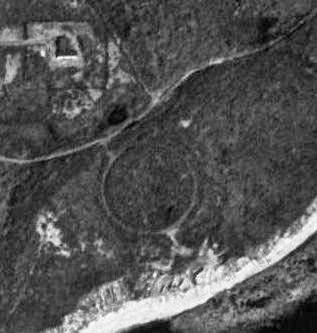

The photo above is an enlargement of the
bottom center section of the previous photo. Notice the ring shaped
artifact measuring approximately 100 yards in diameter. A cross
check of the USGS topological survey map indicates the artifact does
NOT correspond to any natural land feature.
This artifact is the visible surface
signature of an underground structure. Manifestations of this kind
are caused by two distinctly different processes.
(1) Disturbance of the
natural aquifer by the underground structure.
(2) EM or heat leakage
from the underground structure modifying surface vegetation
growth.
A 100 yard ring is too small to be a
primary particle beam accelerator, however it is just the right size
for an electron synchrotron of the type used to create a partial
vacuum "tunnel" through the atmosphere to the target (see NSLS,
Brookhaven analysis far above).
Another use for electron synchrotron generated radiation is human
behavior modulation (mind control). While the radiation it self is
pure EM, the electron synchrotron generation process allows access
to parts of the EM spectrum that are not normally available through
the use of conventional RF generators. These wavelengths are
particularly useful since they are of the same scale (size) as
certain microstructures within the human brain.
Furthermore, since the wavelengths in
question do not occur in the natural environment, the human brain
has no innate immunity. The high power levels that can be achieved
with an electron synchrotron allow many subjects to be "treated"
simultaneously.
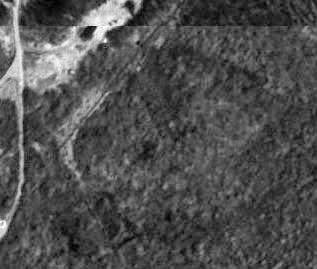

The above photo is another enlargement
from a section of the first photo. Again we see a ring shaped
artifact (albeit better hidden). The artifact is more indicative of
aquifer disruption than direct vegetation disturbance. This ring is
located above, and slightly to the left of the smaller ring shown in
the previous photo. Also, once you know where to look, the ring is
actually more noticeable in the large photo above this one.
With an approximate diameter of 275 yards, the ring is about the
same size as the AGS particle accelerator at Brookhaven. The ring
could be a primary particle beam accelerator, but with the
Brookhaven facility so close, a better use would be as a secondary
storage ring for the primary particle beam accelerator rings at
Brookhaven.
This conclusion is supported by the fact
that accelerators require considerably more power than storage
rings, and a plethora of ancillary equipment that would represent
needless duplication of the Brookhaven facilities. Locating the
particle beam weapon launch facility is more problematical.
At Brookhaven the dual use nature of the
facilities makes the task relatively easy, however the Montauk
underground complex is by definition a covert (secret) base and
therefore far less clues are available for analysis.
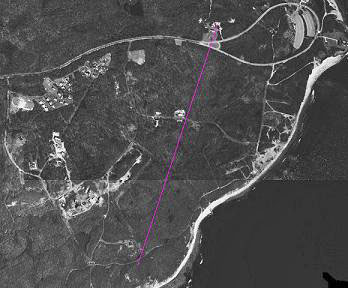 
Assuming the particle beam weapon launch
facility isn't completely camouflaged, and assuming the two rings
connect to the launch facility via straight beam line, the best
choice for the particle beam launch line shown in the photo above.
The second photo on the right
shows an enlarged view of the suspect particle beam launch point. It
is interesting to note that ALL of these particle beam weapon
components are outside the fenced off portion of CHMR. A classic
example of misdirection, and the "hide it in plain sight" doctrine.
An analysis of the time portal systems is beyond the scope of this
document. Suffice it to say that experiments involving time
displacement are unbelievably dangerous and therefore an isolated
site, located well away from major population centers and valuable
infrastructure (such as Brookhaven national laboratory) is
advisable.
Yet the nature of these experiments also
require access to energy concentrations that can only be achieved by
particle accelerators (such as Brookhaven). Based on this set of
requirements, Montauk point (and CHMR) would seem to be the ideal
compromise. However, it is the authors opinion that if an accident
does occur, Montauk will prove to be entirely too close for
comfort...
Support Facilities:
An operation of this magnitude requires considerable above ground
support facilities. In particular, particle beam components are
large and cumbersome, therefore they must be trucked into the site.
A line of trucks, waiting to unload their cargo would be a dead
give-away, furthermore truck drivers are notorious gossip mongers.
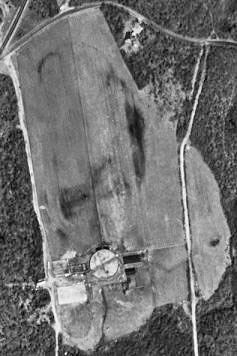
Therefore a nearby cargo container
staging yard is needed. Located on old Montauk highway, at the
junction with the new Montauk highway, the area shown in the photo
above would make an ideal cargo container staging yard. The large
circular structure near the bottom of the photo does not cast much
shadow, and is most likely an "in ground" tank.
Summary:
The Montauk (and CHMR) site show most of the classic indicators of
an underground access point. Furthermore, the identified artifacts
(above) are commensurate with the alleged facility uses,
both in terms of size and shape, and in terms of geographic
relationship to each other.
Therefore, it is the authors opinion the
Montauk point state park, and CHMR are in fact a covert underground
facility, operating under the aegis of the United States government.
Back to Contents
TWA Flight 800
Analysis
TWA flight 800 overview:
On July 17, 1996 at 8:31PM (EDT) TWA flight 800, a Boeing 747-100
(registration N93119) experienced an in-flight explosion just 12
minutes, 51 seconds after being cleared for take off from JFK
international airport. The explosion took place over the Atlantic
Ocean (Location: 72:37.46N, 40:39.52W), approximately 9 miles south
of East Moriches on Long Island, New York. Of the 18 crew members
and 212 passengers on board, none survived.
The ensuing NTSB (national
transportation safety board) investigation was the most thorough and
comprehensive in American aviation history. Yet no definitive cause
for the explosion was ever discovered. In it's final report, the NTSB lists the probable cause as an explosion in the center wing
fuel tank.
The lack of a definitive cause has led some people to theorize that
TWA flight 800 was struck by a surface to air missile. This
speculation is fueled by the reports of several eye witnesses who
claim to have seen a bright point of light ascend upward,
intersecting the aircraft at the time of the explosion. However NO
physical evidence of a missile strike was ever found in the
wreckage...
I believe that TWA flight 800 was the victim of a particle beam
weapon attack, launched from the Brookhaven national laboratory in
order to test system effectiveness against air born targets. This
would not be the first time an agency of the American government has
used unsuspecting citizens as experimental test subjects.
One need look no farther than
the
Tuskegee syphilis study, or the 1950s
nuclear bomb tests on army
personnel to discover how little regard the American government has
for the lives of it's citizens.
The evidence for this theory falls into two broad categories:
1. Flaws in the NTSB probable cause,
and certain investigative steps that were performed in a
superficial manner.
2. The presence of certain physical and logistical indicators
that were completely ignored by the NTSB.
I shall cover each separately, starting
with category number one.
Flaws and superficial performance:
Commercial jet fuel (known as JP4) is a refined variant of kerosene,
very similar to common diesel fuel used in trucks and buses. Unlike
gasoline, JP4 has a low vapor pressure. In other words, it does not
evaporate quickly. As anybody who has ever worked around diesel fuel
will attest, an open container of diesel does not evaporate, even
over time spans measured in days.
While kerosene stoves are no longer
common, anybody who has used one will tell you that dropping a lit
match into the fire box does not work. The match is extinguished.
You must use a piece of paper to act as a wick in order to ignite a
kerosene fire.
The NTSB claim of an explosion in the center wing fuel tank as the
probable cause, while consistent with much of the physical evidence,
leaves the question of ignition source completely unanswered. This
is the fatal flaw in the NTSB probable cause.
The following are excerpts from the NTSB Medical/Forensic Group
Chairman's Factual Report of the investigation (exhibit 19A).
************ Beginning of Excerpts
************
The first 99 bodies were found floating on the surface of the
ocean and were recovered by various civilian, military, and
police vessels during the night of July 17, 1996, and throughout
the day of July 18, 1996. The majority of the remaining victims
were recovered by U. S. Navy divers and local police divers
during the next 96 days.
Pertinent data on the location victims were found, when
available, and the circumstances of the recoveries of the
victims were also recorded. The remains were then placed in a
refrigerated trailer and transported to the Suffolk County
Medical Examiner's Office (ME) in Hauppage, NY.
At the Medical Examiner's Office, the remains of the victims
were:
(1) photographed with and
without clothing
(2) radiographed
(3) fingerprinted if
possible
(4) dentition was
photographed and x-rayed
(5) clothing and other
personal effects were cataloged
All victims were then autopsied by a
forensic pathologist from either the ME or a pathologist
temporarily assigned to the ME by the State of New York or a
neighboring jurisdiction. The ME had 5 autopsy tables available
and during the early recovery efforts, all tables were utilized.
The thoroughness of the forensic post-mortem examinations was
highly variable depending primarily upon the pathologist who
performed the autopsy and upon case flow. The primary objective
of the ME was to identify all remains, and the ME was under
constant and considerable pressure to do so with minimal delay.
Consequently, a high priority was
not placed on performing a detailed forensic autopsy directed
toward elucidating mechanisms of injury.
An effort was not made to relate
damage to clothing with wounds on the body. Foreign material
removed from the bodies was immediately released to an FBI
technician, but autopsy reports did not record whether the
material was found loosely within the body bag, in open wounds,
or whether the foreign body had penetrated the skin and was
found lodged in tissue. Trajectory information was not recorded.
No record of the condition of the tympanic membranes of the
victims was made.
************ End of Excerpts ************
As the above excerpts show, of the 230
passengers and crew, 99 bodies were recovered in the first 36 hours.
The bodies were stored in a refrigerated truck. The ME had 5 autopsy
tables available, AND all 5 were used.
Assume 4 hours per body to perform a comprehensive autopsy, with two
shifts working 8 hours each. With 5 autopsy tables, 20 autopsies per
day can be performed, and therefore 99 bodies can be autopsied in
just 5 days. Yet the final excerpt paragraph states the ME was under
"considerable pressure" to perform with minimal delay, AND the rest
of this paragraph enumerates all of the procedures that were NOT
performed during the autopsies.
Perhaps most telling, is the last
sentence which states that no record of tympanic membrane (ear drum)
condition was made. Such a record would have been conclusive
evidence of cabin over pressure (internal explosion), or abrupt
cabin depressurization (external explosion).
To perform autopsies in such a superficial manner, in a situation
where the evidence uncovered by those autopsies may help in
determining the precise cause of an aircraft explosion, boarders on
criminal negligence! Unless of course the true cause is already
known, and thorough autopsy reports would raise questions that could
prove even more embarrassing than apparent negligence.
Physical indicators:
The photo on the right shows TWA 800 Engine No. 2 fan hub and
blades. The blades are made from an alloy of 90% Titanium, 5.6%
Aluminum, 4.2% Vanadium, and 0.2% Iron. Because this alloy is both
very strong, and extremely brittle, the blades are cast in their
final shape to minimize the amount of machining required. Under
normal conditions, they will break rather than bend. Yet as the
photo clearly shows, many of the blades are bent, some by as much as
90 degrees.
How do I support this conclusion? Compare this photo to the next
photo.
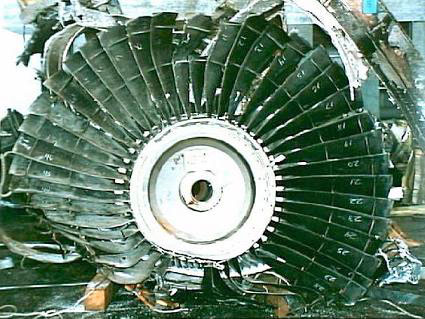
Photo Courtesy of
NTSB
The photo shows two views
of a typical fan blade failure. In this case, one of the blades
suffered progressive fatigue cracking at the root where it connects
to the fan hub. The failure occurred on January 31, 2001 on a Boeing
777-300 at Melbourne International Airport, during the take-off run,
and the flight was safely aborted.
Notice how many of the remaining blades
are missing portions of their tips, and one blade (adjacent to the
missing blade) broke off at it's mid-section. However, none of the
blades show ANY sign of bending, even though this engine (unlike TWA
800) was operating at full take-off power when the failure occurred.
Clearly, something very odd AND very extreme took place in the final
moments of TWA flight 800.
Furthermore, the TWA 800 photo is intentionally posed in such a
manner as to imply the blades were bent by the weight of the
hub/blade assembly, thereby removing any remaining doubt of
complicity on the part of the NTSB. The NTSB while creating the
illusion of great diligence, was in fact, a willing participant in a
cover-up of monumental proportions.
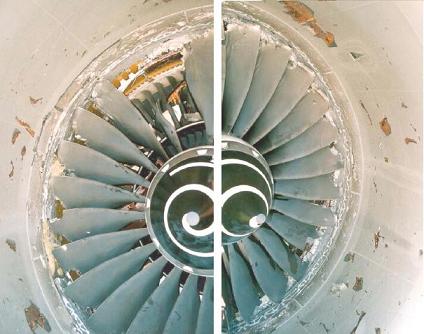
Photo Courtesy of
ATSB
Logistical indicators:
The following is a partial transcript from the cockpit voice
recorder (CVR) of TWA flight 800, during the last 6 minutes before
the explosion. (NTSB exhibit 12A)
RDO = Radio transmission from
aircraft
CTR = Boston ARTCC Controller (center)
-2 = Voice identified as First
Officer (right seat)
CAM = Cockpit Area Microphone sound or source
|
|
|
|
|
|
|
TWA eight hundred what's
your rate of climb?
|
|
|
|
TWA's eight hundred
heavy ah about two thousand feet a minute here until
accelerating out of ten thousand.
|
|
|
|
roger sir climb and
maintain flight level one niner zero and expedite
through fifteen.
|
|
|
|
TWA's eight hundred
heavy climb and maintain one niner zero and expedite
through one five thousand.
|
|
2026:24 |
|
TWA eight hundred amend
the altitude maintain ah one three thousand thirteen
thousand only for now.
|
|
|
|
TWA's eight hundred
heavy okay stop climb at one three thousand.
|
|
|
|
TWA eight hundred you
have traffic at one o'clock and ah seven miles south
bound a thousand foot above you he's ah Beech
nineteen hundred.
|
|
|
|
TWA's ah eight hundred
heavy ah no contact.
|
|
|
|
TWA eight hundred climb
and maintain one five thousand.
|
|
|
|
TWA's eight hundred
heavy climb and maintain one five thousand leaving
one three thousand.
|
|
|
|
((sounds similar to
recording tape damage noise)).
|
|
|
|
|
At 2025:41 Boston center instructs TWA
800 to climb to 19 thousand feet, and to expedite the climb through
15 thousand feet. TWA 800 acknowledges 6 seconds later.
Approximately 37 seconds after acknowledgement, at 2026:24 Boston
center amends it's instructions to TWA 800. Instead instructing TWA
800 to climb and maintain 13 thousand feet. TWA 800 acknowledges 6
seconds later.
Finally, at 2030:15, less than one minute before the explosion,
Boston center instructs TWA 800 to climb to 15 thousand feet. TWA
800 acknowledges 4 seconds later.
Why did Boston center amend it's climb instruction to TWA 800? Was
there other conflicting traffic in the vicinity? The nearest traffic
was a Beach 1900, 7 miles away, at TWA 800's 1 o'clock position,
heading south. Since TWA 800 was heading east, this puts the Beach
1900 safely past TWA 800's flight path.
By keeping TWA 800 at 13 thousand feet, and issuing the climb
instruction just 50 seconds before the particle beam strike, the
aircraft would still be climbing, thereby presenting a greater
surface area for target acquisition. Was Boston air traffic control
center involved in this hideous test of a covert weapons system? The
evidence seems substantial.
The plot on the right shows radar data (the blue dots), obtained by
the NTSB from the Islip radar station on Long Island NY. Each dot
shows the position of a an aircraft as the radar beam swept over the
aircraft (the solitary, and closely spaced dots are slow moving
water craft). For instance, dot 3 in each series is the position of
that aircraft on the third sweep of the radar beam. The plot shows
the last 9 radar sweeps, before the destruction of TWA 800.
Notice the aircraft labeled "Navy P-3" moving southwest. This is an
anti-submarine patrol craft, equipped with highly advanced
electronic surveillance systems. The aircraft would make an ideal
observation platform to record the results of a covert particle beam
weapon test.
The P-3 is also a very robust aircraft
(a variant is used for hurricane hunting), likely to survive even if
it gets a bit too close to the target aircraft (TWA 800).
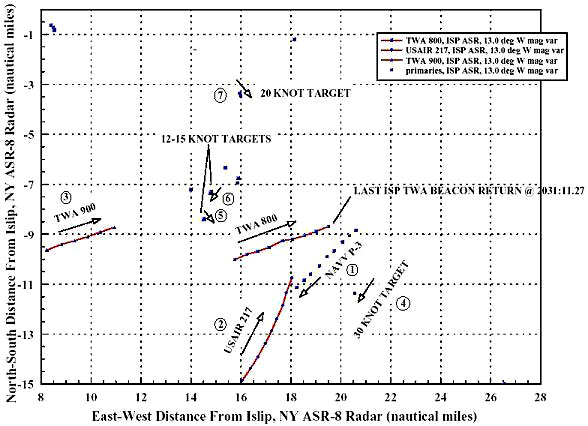
Part of exhibit 13A.
Plot Courtesy of NTSB
Coincidently, the P-3 was flying at an
altitude of just over 19 thousand feet, approximately the same
altitude as TWA 800 was originally instructed to climb and maintain,
before amendment by Boston air traffic control (see above).
Obviously someone was worried about the surveillance aircraft being
a bit too close to the test. According to the navy, this aircraft
was on a "routine training mission"...
Effects of a particle beam weapon
strike:
An aircraft struck by a particle beam weapon will suffer two
distinctly different types or classes of damage.
(1) Kinetic damage.
(2) Electro-magnetic damage.
Each class of damage will have a unique
signature, neither of which is likely to be recognized by personnel
trained in common explosives and/or structural failure mechanisms.
The electro-magnetic damage will be the most unusual aspect of a
particle beam weapon strike. The EMP (electro-magnetic pulse) will
be dissipated in the immediate vicinity of the strike point, causing
radical rearrangements in the chemical structure of the material.
The material will momentarily soften, as if subjected to intense
heat, but without the normal indications of thermal stress.
Strikes on a living organism would
result in intense localized cellular disruption, similar to
microwave cooking, but again without the normal indicators of
elevated temperature. This effect would be very noticeable during a
thorough forensic autopsy, yet completely inconsistent with usual
surface style heating produced by a conventional explosion. If a
fuel tank were to suffer a direct strike, ignition would be
instantaneous, regardless of vapor pressure and/or combustibility of
the fuel.
The kinetic damage will superficially resemble traditional
structural failure. The primary cause will be violent shockwaves
emanating from the strike point(s), and traveling through structural
members. The result will be fracturing at locations where the
shockwaves concentrate, either through geometric focusing, or
through standing waves created by reflections.
The structure will literally fall apart
into thousands of small pieces. The appearance will closely resemble
the recovered fuselage wreckage of TWA flight 800...
Back to Contents
|
















